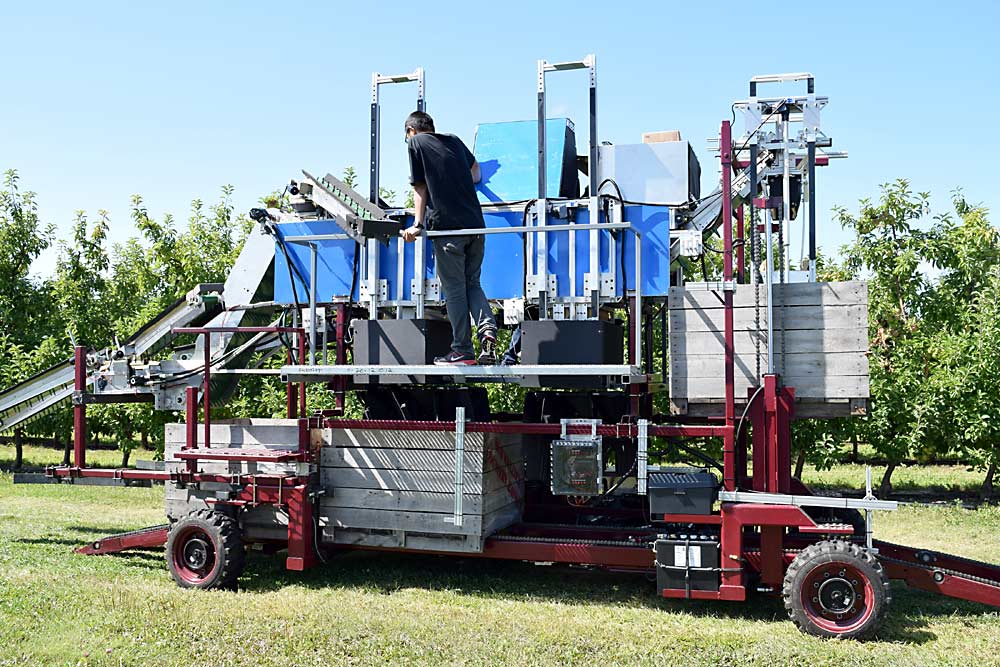
The cost for harvest labor equates to about 15 percent of total production expenses, so it is an area worth examining for possible automation, according to Renfu Lu, an agricultural engineer with the USDA Agricultural Research Service. Lu led a study to determine how pickers spend their time during harvest. The study included workers using the traditional bucket-and-ladder approach, a platform system or a vacuum-tube harvester. Shown here, the DBR vacuum harvester allows pickers to place apples in vacuum tubes rather than buckets. (Courtesy Renfu Lu)
When it comes to growing apples, one part of the process begging for greater productivity is harvest, and especially the efficiency of pickers, according to a new study that teased out exactly how pickers spend their days.
Some picker activities seem especially ripe for intervention by new robotic and otherwise automated systems, according to Renfu Lu, who presented the study results at the Great Lakes Fruit, Vegetable and Farm Market Expo on Dec. 6. An agricultural engineer with the USDA Agricultural Research Service, Lu hopes to improve harvest proficiency with his own group’s advanced technology, including a newly patented automated sorting technology that he hopes to field-test in 2019.
The study, funded by the Michigan Apple Committee, had two objectives. One was to figure out how pickers are spending their time and determine the physical difficulty of tasks, and the other was to develop new technology to make apple picking more efficient, productive and easier on workers.
Where does the time go?

Renfu Lu
Analyses of the videotapes showed that ladder-and-bucket pickers typically spend about a third of their time on what Lu called “nonpicking activities,” such as moving and climbing ladders, walking to and from the bin, dumping the apples and gathering runaway apples from the ground.
For the Huron harvest platform system, workers spent only 14 percent of their time on nonpicking activities, primarily because the bins were either immediately behind them (for those on the platform) or fairly nearby (for those picking from the ground). With the DBR vacuum harvester, workers spent nearly a fifth of their time on nonpicking activities, much of it because the system has a hydraulic platform, and picking stopped while the platform was moving.
Next, the researchers looked only at the picking activities, which they categorized as reaching for apples, plucking or detaching the apples from the tree, and putting the apples into the bucket or vacuum tube.
The results for all three harvesting methods were similar: 24 to 29 percent of the picking time went toward detaching fruit from the tree, with the remainder split between the so-called “noneffective picking activities” of reaching for apples and loading them into the bucket or vacuum tube.
“There is huge opportunity for improving harvest productivity by reducing the time for noneffective picking activities,” Lu said.
New technologies
Robotic technologies may be useful for speeding the harvest someday, but they aren’t ready for the average grower quite yet, Lu said. Many of the new technologies use an apparatus that mimics the human arm and hand: a robotic arm reaches toward the fruit and a hand-like tool grasps and detaches the apple.
“It is easy for a human to pick an apple, but for a robot, it is tough,” he said. Lu listed some of the issues: robots are much slower than humans in picking fruit, they need accurate information about the location of apples in three-dimensional space, and they have a difficult time reaching into deep canopy. In addition, when the apples are in a cluster, the hand tool can hit neighboring apples and bruise them.
“So, my perspective on robotic harvesting of apples is that since most robotic harvesters mimic human arms and hands, their performance is not going to be better than that of humans, which means these robots will not be very cost-effective,” he said. “I don’t think the average grower in Michigan is willing to invest in these technologies yet.”
That said, Lu’s group is working on the design and development of its own apple harvest technology that includes the ability to sort apples in the field to remove culls and, as a result, reduce the costs of postharvest handling.
The researchers now have a prototype of the technology, which includes a platform that is adjustable both horizontally and vertically and a receiving station located between the tree and picker to allow faster harvesting.

Lu’s group is developing its own harvesting technology, shown here, that incorporates automated in-field sorting to separate culled fruit. The researchers will test the new technology this year. (Courtesy Renfu Lu)
The machine can sort apples automatically at a rate of up to nine fruit per second, accommodating a harvest crew of at least six people, he said. Rollers and a spinning pinwheel guide the fruit — bruise-free — into either a fresh bin or a cull bin. The system also has an automatic bin function to load empty bins and release full bins.
Lu’s group is continuing to refine its prototype and plans to test the in-field sorting system in the upcoming season.
Wait and see
Lu is also interested in the possibility of employing soft robotics, or robots made from flexible materials, in apple-picking technologies in the future and has his eye on other projects that are in development.
“We need some new concepts or approaches to robotic harvesting, not just mimicking humans,” he said. “Human is best and no machine is going to exceed human.”
In the meantime, growers can pave the way for automatic harvesting technologies by moving away from tall trees and going to some of the new tree architectures that will make the apples easier for robots to find and harvest. “The industry is already moving in that direction, which is good,” Lu said.
“My final thought is the average grower is not going to adopt new robotic technology unless it can perform mass harvesting of apples, which means that it far exceeds human productivity,” Lu said. Although such automation isn’t available quite yet, new projects are in the works. “Please stay tuned,” he said. •
—by Leslie Mertz






Leave A Comment